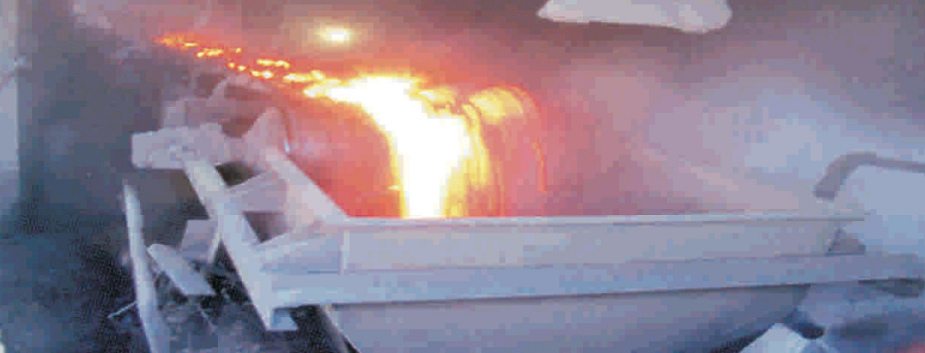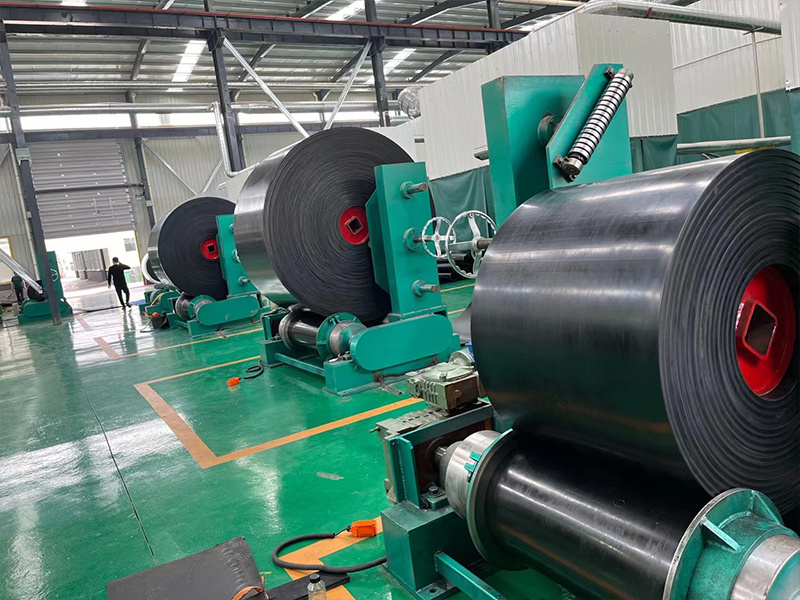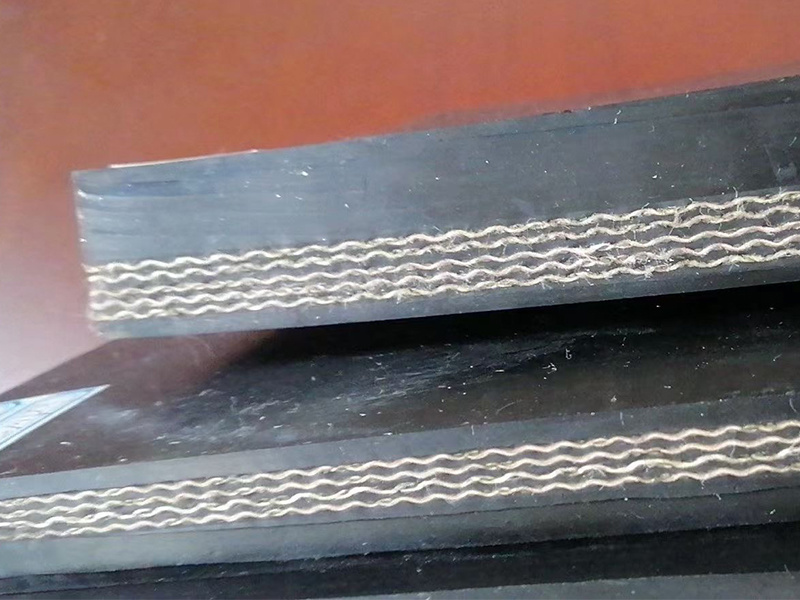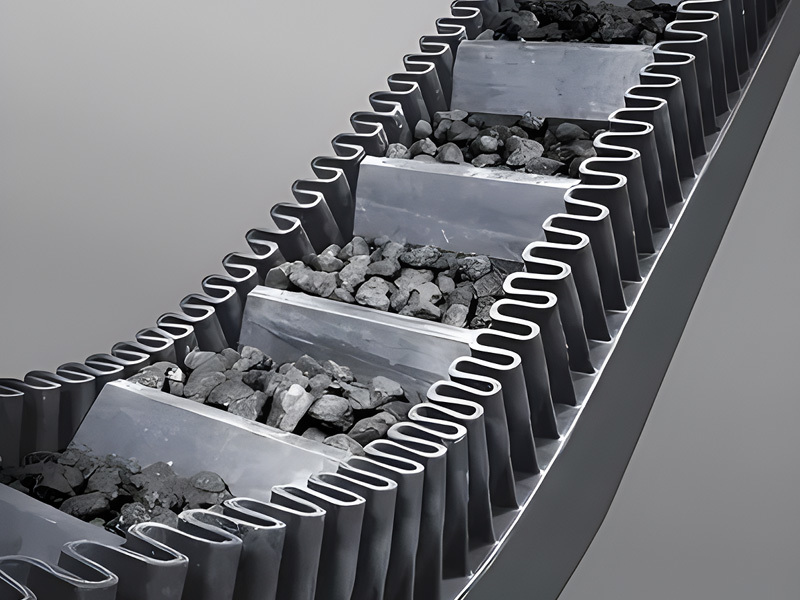Products
Contact Information
Address: China (Boye) conveyor belt Industrial zone
Telephone:+86 18395653111
Mailbox:colin@bestbelting.com
Heat resistant and high temperature resistant conveyor belt
Keyword:
Heat resistant and high temperature resistant conveyor belt
1. uses
The heat-resistant conveyor belt is mainly used for conveying high-temperature materials, such as sinter hot coke, cement clinker, hot castings, etc. According to the main performance of heat-resistant belt damage and loss of conveying capacity and different heat-resistant levels, EPDM or SBR are used as covering rubber respectively. High-strength and high-permeability polyester canvas or cotton canvas is used as strong layer. Heat-resistant glass cloth can be laid between the covering glue and the skeleton to improve the service life of the heat-resistant belt. According to customer requirements, can be made into a ring belt.
Heat resistant and high temperature resistant conveyor belt is widely used in coal, mining, port, metallurgy, electric power, chemical industry and other fields to transport materials.
2. features:
1. High strength, thin belt and light weight.
2. Use EP dipped canvas as skeleton material.
3. The belt body is soft, the groove is better, and the elasticity is better.
4. Impact resistance, wear resistance, corrosion resistance.
5. Adapt to large load, fast speed and medium and long distance material transportation.
6. Smooth operation, no deviation.
3. specifications and technical parameters
| Specifications and Technical Parameters of Polyester Multilayer Conveyor Belt | ||||||||||
| Fabric Type |
Fabric construction | Fabric type | Thickness of adhesive tape | Strength series (N/mm) | Cover glue thickness (Mm) |
Width Scope (mm) |
||||
| By | Weft | Layer 2 | Layer 3 | 4 floors | Upper cover glue | Lower cover glue | ||||
| Polyester (EP) |
Polyester | cotton nylon | EP-80 | 1.00 | 160 | 240 | 320 | 0-12 | 0-10 | 300-2500 |
| EP-100 | 1.00 | 200 | 300 | 400 | ||||||
| EP-125 | 1.05 | 250 | 375 | 500 | ||||||
| EP-150 | 1.10 | 300 | 450 | 600 | ||||||
| EP-170 | 1.10 | 340 | 510 | 680 | ||||||
| EP-200 | 1.20 | 400 | 600 | 800 | ||||||
| EP-250 | 1.40 | 500 | 750 | 1000 | ||||||
| EP-300 | 1.60 | 600 | 900 | 1200 | ||||||
| EP-350 | 1.70 | 1050 | 1400 | |||||||
| EP-400 | 1.90 | 1600 | ||||||||
| EP-500 | 2.10 | 2000 | ||||||||
4. adhesive strength, elongation performance in accordance with the following table
| Adhesion strength, elongation performance | |||||
| with core Materials |
bond strength | Extension performance | |||
| Interlayer N ≥ mm | Covering layer and layer N/mm |
Full thickness longitudinal elongation at break | Full thickness longitudinal reference force elongation | ||
| Covering layer thickness ≤ 1.5mm | Covering layer thickness ≥ 1.5mm | ||||
| Polyester Canvas | ≥ 5 | ≥ 4.5 | ≥ 5 | ≥ 10% | ≤ 4% |
The covering performance of the 5. tape shall comply with the following table
| Covering performance of tape | |||||
| Overlay Level | Tensile strength | Elongation at break | Abrasion | Change rate of tensile strength and elongation at break after aging | |
| Mpa | Kgf/cm2 | % | mm3 | % | |
| H | 24 | 240 | 450 | 120 | -25 ~ 25 |
| D | 18 | 180 | 400 | 100 | -25 ~ 25 |
| L | 15 | 150 | 350 | 200 | -25 ~ 25 |
The physical and mechanical properties of the 5. heat resistant coating after the heat resistance test shall meet the requirements of the following table
| Project | Model | ||||
| T1 | T2 | T3 | T4 | ||
| Range of change | |||||
| Hardness | Difference between after aging and before aging | 20 | 20 | ±20 | ±20 |
| Larger value after aging | 85 | ||||
| Tensile strength | Minimum value after aging | 12 | 10 | 5 | 5 |
| Performance change rate/% | -25 | -30 | -40 | -40 | |
| Elongation at break | Performance change rate/% | -50 | -50 | -55 | -55 |
| Minimum value after aging | 200 | 200 | 180 | 180 | |
| German Standard DIN-22102 | ||||||
| Grade | Tensile strength ≥ Ma | Elongation at break ≥ M% | Abrasion ≥ mm3 | Adhesion strength between layers of cloth (N/mm) | Adhesion strength between cover layer and cloth layer (/mm) | |
| Covering layer thickness 0.8~1.5mm | Cover layer thickness> 1.5mm | |||||
| W | 18 | 400 | 90 | ≥ 5 | 3.5 | 4.5 |
| X | 25 | 450 | 120 | |||
| Y | 20 | 400 | 150 | |||
| Z | 15 | 350 | 250 | |||
| English Standard BS 490 | ||||||
| Grade | Tensile strength ≥ Ma | Elongation at break ≥ M% | Abrasion ≥ mm3 | Adhesion strength between layers of cloth (N/mm) | Adhesion strength between cover layer and cloth layer (/mm) | |
| Covering layer thickness 0.8~1.5mm | Cover layer thickness> 1.5mm | |||||
| M | 24 | 450 | - | ≥ 5.25 | 3.15 | 4.5 |
| N | 17 | 400 | - | |||
| Australian Standard AS 1332-2000 | ||||||
| Grade | Tensile strength ≥ Ma | Elongation at break ≥ M% | Abrasion ≥ mm3 | Adhesion strength between layers of cloth (N/mm) | Adhesion strength between cover layer and cloth layer (/mm) | |
| Covering layer thickness 0.8~1.5mm | Cover layer thickness> 1.5mm | |||||
| A | 17 | 400 | 70 | 6 | 4 | 4.8 |
| E | 14 | 300 | - | |||
| F | 14 | 300 | - | |||
| M | 24 | 450 | 125 | |||
| N | 17 | 400 | 200 | |||
| S | 14 | 300 | 250 | |||
| S* | 12 | 300 | 250 | |||
| South Africa SANS 1173:2005 | ||||||
| Grade | Tensile strength ≥ Ma | Elongation at break ≥ M% | Abrasion ≥ mm3 | Adhesion strength between layers of cloth (N/mm) | ||
| Adhesive strength between cover layer and cloth layer (N/mm) | ||||||
| A | 18 | 400 | 90 | ≥ 7 | ≥ 5 | |
| X | 25 | 450 | 120 | |||
| M | 24 | 450 | 150 | |||
| N | 20 | 400 | 250 | |||
Specification and Technical Parameters of Nylon Multilayer Fabric Core Conveyor Belt
| Fabric Type | Fabric construction | Fabric type | Thickness of adhesive tape (mm/p) | Strength series (N/mm) | Cover glue thickness | Width range (mm) | ||||||
| By | Weft | Layer 2 | Layer 3 | 4 floors | 5 floors | 6 layers | Upper covering layer | Lower cover | ||||
| Nylon | cotton nylon | cotton nylon | Nn-100 | 1.00 | 200 | 300 | 400 | 500 | 600 | 0-12 | 0-10 | 300-2500 |
| Nn-125 | 1.05 | 250 | 375 | 500 | 625 | 750 | ||||||
| Nn-150 | 1.10 | 300 | 450 | 600 | 750 | 900 | ||||||
| Nn-200 | 1.20 | 400 | 600 | 800 | 1000 | 1200 | ||||||
| Nn-250 | 1.40 | 500 | 750 | 1000 | 1250 | 1500 | ||||||
| Nn-300 | 1.60 | 600 | 900 | 1200 | 1500 | 1800 | ||||||
Adhesive strength, elongation performance in accordance with the following table
| Adhesion strength, elongation performance | |||||
| Core material | bond strength | Extension performance | |||
| Interlayer N/mm | Covering layer and layer N/mm | Full thickness longitudinal elongation at break | Full thickness longitudinal reference force elongation | ||
| Covering layer thickness ≤ 1.5mm | Covering layer thickness ≥ 1.5mm | ||||
| Polyester Canvas | ≥ 5 | ≥ 4.5 | ≥ 5 | ≥ 10% | ≤ 4% 6 |
The covering performance of the tape is in accordance with the following table
| Covering performance of tape | |||||
| Overlay Level | Tensile strength | Elongation at break | Abrasion | Change rate of tensile strength and elongation at break after aging | |
| Mpa | Kgf/cm2 | % | mm3 | % | |
| H | ≥ 24 | ≥ 240 | ≥ 450 | ≤ 120 | -25~ 25 |
| D | ≥ 18 | 180 | ≥ 400 | ≤100 | -25~ 25 |
| L | ≥ 15 | 150 | ≥ 350 | ≤200 | -25~ 25 |
Application Real Scene







FAQ
Characteristics of Polyester Conveyor Belt
High modulus, low elongation, good heat stability, impact resistance and other characteristics, suitable for medium and long distance, high-speed, high-speed conditions of conveying materials.
Body material for heat-resistant conveyor belts
The subject material of the heat-resistant conveyor belt includes a skeleton material, a covering layer and a base material.
Selection of the diameter of the conveying roller
The selection of roller diameter should consider the following factors: the average specific pressure between the conveyor belt and the roller surface, the amount of deformation of the bag and the bag, the utilization rate of the allowable strength of the conveyor belt, the frequency of bending of the conveyor belt, the installation location of the conveyor and the conditions of use.
Main material of nylon conveyor belt
The main material of the nylon conveyor belt is nylon, but it does not have enough tension, so it is necessary to add a layer of industrial polyester cloth between nylon and nylon to increase the tension when making the finished product.
The advantages of the pattern conveyor belt
The pattern conveyor belt can ensure the smooth transportation of materials, with anti-skid, impact resistance, and high temperature resistance.
Related Products
Product inquiry
To: Baoding Fangnuo Rubber Products Manufacturing Co., Ltd.
















